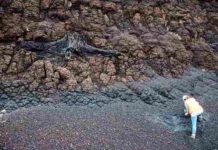
Scientists have discovered the cause of a mass extinction of sea-floor marine organisms 800,000 years ago—which also provides insight into how climate change can impact on deep ocean biota.
In a new study published in the journal Nature Communications, scientists from the universities of Nottingham and Durham and the British Geological Survey (BGS), have discovered the cause of a mass extinction within marine organisms called foraminifera. Foraminifera are an important group in relation to biomass in the deep ocean and the cause of their extinction was previously unknown.
Scientists tested various possible causes for the mass extinction and were able to discount others such as ocean cooling. Instead they discovered that the extinction was caused by a global change in plankton at the surface of the ocean.
Important group of organisms
These plankton (coccolithophores) are the food source for seafloor-living foraminifera, and are an important group of organisms at the base of the food web for all life in the ocean (for example, krill, fish, whales). They ‘bloom’ at certain times of the year in such numbers that it is sometimes visible from space.
Dr Sev Kender from The School of Geography at The University of Nottingham, said: “We discovered that the sea-floor foraminifera probably went extinct because their food source changed, becoming more variable throughout the year.
“This is important as it has been an enigma, and because future climate change will impact on plankton and therefore the deep ocean biosphere. We have shown that surface ocean changes can adversely impact deep sea communities.”
‘Human activities have caused the extinction of many life forms’
The research was carried out by measuring the chemistry and fossil content of International Ocean Discovery Program (iodp.tamu.edu), sediment cores from the Tasman Sea near New Zealand.
“We know that human activities have caused the extinction of many life forms already, and there is widespread interest in trying to minimise this impact in the future. Understanding how sensitive life is to environmental change is therefore potentially important,” says Dr Kender.
“We have discovered what caused a mass extinction (many past extinctions are not yet understood), and we have shown that the deep ocean biosphere is sensitive to changes in surface ocean biology, which is being impacted by human-driven environmental change.”
The study forms one part of a large Natural Environment Research Council (NERC)
Project aiming to reconstruct how climate change in the past implicated the oceans, specifically over the past three million years. This is in terms of ocean temperature, circulation, and life in the oceans.
NERC Project Leader and co-author Dr Erin McClymont (Durham University), said “The novelty of our approach comes from our study of both the pattern of the extinction and the properties of the water in which those organisms were living. This allowed us to directly test which factors might have caused the extinction event.”
The work carried out by the team will be used by the science community that is researching the evolution of life on earth, and that is investigating the biogeochemical cycles in the oceans during past climate change events.
Reference:
Mid Pleistocene foraminiferal mass extinction coupled with phytoplankton evolution. DOI: 10.1038/ncomms11970
Note: The above post is reprinted from materials provided by University of Nottingham.










